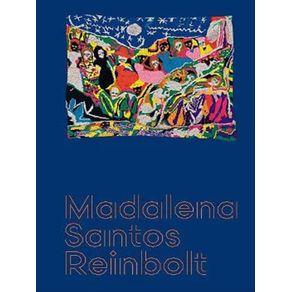Este é o primeiro livro dedicado à produção visual de Madalena Santos Reinbolt (1919-1977), abrangendo as décadas de 1950 a 1970. A artista é reconhecida por seus complexos bordados construídos com centenas de vibrantes linhas de cores — os chamados “quadros de lã”. Neles, Santos Reinbolt representou a vida cotidiana no campo e na cidade, repleta de personagens negros: encontros, festas, celebrações, religiosidades, refeições coletivas. Amplamente ilustrada, a publicação inclui quatro ensaios e uma nota biográfica especialmente escritos para ocasião e um texto histórico, além de reproduzir 53 obras da artista. A despeito de sua rica e singular produção, Santos Reinbolt produziu às margens dos circuitos tradicionais de arte em seu tempo. Apenas nos últimos anos sua obra começou a despertar mais atenção. Este livro acompanha a primeira exposição individual da artista, no Museu de Arte de São Paulo Assis Chateaubriand, e busca reposicionar a artista na história da arte brasileira da segunda metade do século 20, numa perspectiva mais diversa e plural. Trata-se de um volume indispensável para quem deseja conhecer ou se aprofundar na excepcional produção artística de Madalena Santos Reinbolt, bem como aqueles interessados nos diálogos e interseções entre arte têxtil, artes visuais e a chamada arte popular, raça, gênero e feminismo no Brasil no meio do século 20.
This is the first book dedicated to the work of pioneering Brazilian artist Madalena Santos Reinbolt (1919–1977), spanning from the 1950s to the 1970s. The artist is recognized for her intricate embroideries made with hundreds of vibrant threads of color—the so-called “wool pictures.” In them, Santos Reinbolt represented everyday life in the countryside and in the city, populated by Black characters: gatherings, festivities, celebrations, religiosities, and collective meals. This publication includes four essays and a biographical note written especially for the occasion, plus a historical text, as well as reproductions of 53 of the artist’s works. Despite her rich and unique production, Santos Reinbolt remained on the fringes of the traditional art circuits in her lifetime, and it is only recently that her work began to attract more attention and recognition. This book accompanies the artist’s first solo exhibition, held at Museu de Arte de São Paulo Assis Chateaubriand, and seeks to reposition her in the history of Brazilian art in the second half of the twentieth century from a more diverse and plural perspective. This is an essential volume for anyone who wants to know or delve into the exceptional artistic production of Santos Reinbolt, as well as those interested in the dialogues and intersections between textile art, visual arts, and popular art, race, gender, and feminism in Brazil in the mid-twentieth century.

